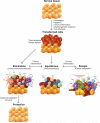The role of complement in tumor growth
- PMID: 24272362
- PMCID: PMC4379038
- DOI: 10.1007/978-1-4614-5915-6_11
The role of complement in tumor growth
Abstract
Complement is a central part of the immune system that has developed as a first defense against non-self cells. Neoplastic transformation is accompanied by an increased capacity of the malignant cells to activate complement. In fact, clinical data demonstrate complement activation in cancer patients. On the basis of the use of protective mechanisms by malignant cells, complement activation has traditionally been considered part of the body's immunosurveillance against cancer. Inhibitory mechanisms of complement activation allow cancer cells to escape from complement-mediated elimination and hamper the clinical efficacy of monoclonal antibody-based cancer immunotherapies. To overcome this limitation, many strategies have been developed with the goal of improving complement-mediated effector mechanisms. However, significant work in recent years has identified new and surprising roles for complement activation within the tumor microenvironment. Recent reports suggest that complement elements can promote tumor growth in the context of chronic inflammation. This chapter reviews the data describing the role of complement activation in cancer immunity, which offers insights that may aid the development of more effective therapeutic approaches to control cancer.
Figures





References
-
- Abbott RJ, Spendlove I, Roversi P, et al. Structural and functional characterization of a novel T cell receptor co-regulatory protein complex, CD97-CD55. J Biol Chem. 2007;282(30):22023–22032. - PubMed
-
- Ajona D, Castano Z, Garayoa M, et al. Expression of complement factor H by lung cancer cells: effects on the activation of the alternative pathway of complement. Cancer Res. 2004;64(17):6310–6318. - PubMed
-
- Ajona D, Hsu YF, Corrales L, et al. Down-regulation of human complement factor H sensitizes non-small cell lung cancer cells to complement attack and reduces in vivo tumor growth. J Immunol. 2007;178(9):5991–5998. - PubMed
Publication types
MeSH terms
Substances
Grants and funding
LinkOut - more resources
Full Text Sources
Other Literature Sources

